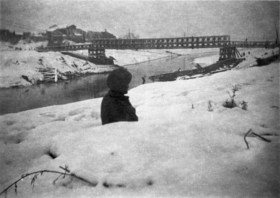Operation Gourding
This article is incomplete because it is pending further input from participants, or it is a work-in-progress by one author. Please comment on this article's talk page to share your input, comments and questions. Note: To contribute to this article, you may need to seek help from the author(s) of this page. |
| Operation Gourding | |||||||
|---|---|---|---|---|---|---|---|
| Part of the Third Joyonghean-Quenminese War | |||||||
 A troop from the 8th New Akiba Division overlooking the Bridge at the Nokdang River following its capture. | |||||||
| |||||||
| Belligerents | |||||||
| Commanders and leaders | |||||||
| Units involved | |||||||
| |||||||
| Casualties and losses | |||||||
|
| ||||||
Operation Gourding (10 November - 25 November 1941) was an Allied operation aimed to penetrate the Pusan Perimeter through the Nokdang River. It was ambitiously planned by Zanarkian General Edward Samegawa. It took 5 Allied divisions, consisting of 2 Zanarkian, 1 New Akibander, and 2 Joyonghean Army Divisions to commit to the plan. During the Battle of Mt. Kimsan, where elements of the 9th Zanarkian Division were holding the area, Samegawa planned to delay his offensive for 3 months in order to force Marshal Hồ Danh Sĩ Quốc's forces to fight him in the midst of the incoming Winter season, where both sides were unable to utilise their movements. Samegawa's experience in fighting in a war of attrition contributed to the success of the plan.
Meanwhile, Marshal Ho had hoped to take Mt. Kimsan in order to give his forces a bird's eye view of the entire region that would allow him to direct movements across the Pusan Perimeter and push the Allies back to the sea. In November 1941, after nearly 3 months of being besieged in the hill, Samegawa ordered Joyonghean General Chae Hwa-young to push her forces south of the mountain while the rest of his forces would relieve the Zanarkians at the hill. By 17 November, Chae was less than 20kms away from the Nokdang River. In an effort to slow the Allied advance, Marshal Ho ordered the destruction of several bridges across the river. By 21 November, only 1 bridge remained intact at the town of Waegwan. Immediately, General Hikaru Komaki's 8th New Akiba Division immediately raced towards Waegwan. Although the division faced stubborn resistance by 2 Iron Tiger Divisions, the New Akibanders successfully prevented the destruction of the bridge by the 23rd of November. On the next day, Allied forces crossed the river, ultimately fulfilling the operation's objective before the end of November and signalling the start of the 1941 Winter Campaign.
Samegawa's plan, although was risky and many Allied commanders have very high doubts on the success had managed to put the Allied offensive back on track, regaining the advantage lost during the Chug-an Campaign.